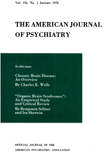EMOTIONAL PROBLEMS OF HIGH BLOOD PRESSURE
Abstract
The organic tradition in medicine has been responsible for a narrow (physical) view of the etiology, pathogenesis, and treatment of essential hypertension. The psychosomatic approach does not neglect the physical problems involved but includes a consideration of the role of emotions. It emphasizes the multiple factors in etiology, pathogenesis, and treatment and attempts to evaluate the resulting composite clinical picture. Such studies indicate that the emotional component apparently is intimately related to the development of hypertension in some patients, to the production of symptoms in many others, and enters into the question of treatment in nearly all patients with this disorder.
All varieties of character and neurotic disturbances occur in hypertensive individuals, but most often the disorder seems to appear in people with compulsive characters. Therefore, inhibited aggression seems to bear a definite relationship to hypertension and, if it can be satisfactorily dealt with by means of psychotherapy, anxiety is diminished and blood pressure is often lowered. Even if blood pressure is unaffected, the treatment often benefits the patient by making him a healthier and more effective personality. Our objectives in treatment should be readjusted. We must do more than try to bring the blood pressure down. We must go beyond the physical aspects of hypertension to the personality of the hypertensive individual in order to be successful in the management of such patients.
Access content
To read the fulltext, please use one of the options below to sign in or purchase access.- Personal login
- Institutional Login
- Sign in via OpenAthens
- Register for access
-
Please login/register if you wish to pair your device and check access availability.
Not a subscriber?
PsychiatryOnline subscription options offer access to the DSM-5 library, books, journals, CME, and patient resources. This all-in-one virtual library provides psychiatrists and mental health professionals with key resources for diagnosis, treatment, research, and professional development.
Need more help? PsychiatryOnline Customer Service may be reached by emailing [email protected] or by calling 800-368-5777 (in the U.S.) or 703-907-7322 (outside the U.S.).



